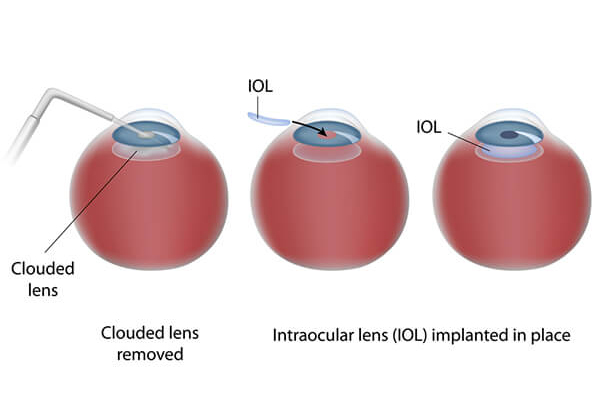
Do you or someone you love have cataracts? You're not alone. Millions of cataracts are removed every year.
You can trust you're in good hands with the expert cataract surgeons at Texas Eye & Laser Center in Fort Worth. We’ve performed thousands of successful cataract procedures using state-of-the-art technology at our dedicated surgical center.
See If You're a CandidateA cataract occurs when the eye's naturally clear and transparent lens becomes opaque. The lens helps focus rays of light onto the retina. It also translates these rays into images for the brain to see.
After the lens starts to cloud, it is impossible to return it to its clear state with medications. Proteins in the lens begin to build up, leading to visual impairment.
As a cataract develops, these proteins start clumping together in the middle of the lens, making it more and more difficult to see clearly. The only way to remove cataracts is to undergo cataract surgery.
The procedure removes the natural lens and replaces it with an artificial lens, called an intraocular lens (IOL). Removing the natural lens and replacing it with an IOL allows you to see clearly once more.
Take Our Cataract Self-Test
There are many symptoms of cataracts. Because it can take years or even decades for cataracts to form, you may not realize you have them at first. Common symptoms of cataracts include:
The trouble with many of these symptoms is they are not exclusive to having cataracts. Some of them overlap with other eye conditions, like presbyopia.
If you suspect you may have cataracts, see your eye doctor. They can determine the cause of these symptoms. If it is cataracts, they'll recommend when it's best to have cataract surgery.
The only way to know if you have cataracts is to see your eye doctor at Texas Eye & Laser Center. During your cataract screening, they will determine if you have cataracts by conducting a comprehensive eye exam.
If you have cataracts, you may not realize that you don't need cataract surgery immediately. Are you having trouble cooking, cleaning, or doing laundry?
Is it much more challenging to participate in your favorite hobbies because of your worsening vision? If you've reached the stage where cataracts keep you from doing the things you love, your cataract surgeon recommends thinking about cataract surgery.
Take Our Cataract Self-Test

An essential component of having cataract surgery is choosing an IOL before the procedure. For the best results, you'll need to discuss your goals and lifestyle needs after cataract surgery with your surgeon.
Based on this information, they can recommend the best lens implant to replace your natural lens. There are numerous intraocular lens options available.
Knowing there are lots of options can be overwhelming, so your cataract surgeon will discuss your choices. You may want to consider a traditional lens implant, called a monofocal lens, which can only correct vision at one distance. Or you may prefer a LifeStyle lens, which provides you with a wide range of focus.
Your cataract surgeon at the Texas Eye & Laser Center will explain the differences between these lenses. Whichever lens you choose will be inserted into your eye after removing your natural lens.
Schedule NowOn the day of your procedure, you'll have a trusted friend or family member drive you to our dedicated surgery center. Before the procedure begins, you'll have your eye cleaned and dilated.
Our Hurst cataract surgeons use a topical anesthetic on the eye. The topical anesthetic ensures you won't feel any pain during cataract surgery. Once the anesthetic starts working, your cataract surgeon will create a small incision. After making this incision, they will use an ultrasonic device to perform phacoemulsification.
Phacoemulsification uses ultrasonic waves to gently break apart the pieces of the proteins that form the cataract. Your cataract surgeon then uses a suction device to remove cataract fragments from the eye. After phacoemulsification, your IOL is gently inserted through the original incision. Your cataract surgeon will ensure it's in place and readjust it as necessary.
The new IOL takes over the job that the natural lens can no longer achieve, staying in your eye permanently. After its insertion, you will not be able to see or feel the artificial lens. No stitches or sutures are required, and your incision will heal independently.


The ORA SYSTEM powered by AnalyzOR Technology is a proven state-of-the-art analysis that provides your cataract surgeon with valuable information about your eye. Using AnalyzOR is clinically proven to significantly improve the rate of outcomes for patients within .5 diopters of the target. AnalyzOR also stores, tracks, and analyzes results for personal and global trends to allow data from each procedure to enhance future ones.
ORA SYSTEM Technology uses real-time measurements of your eye during cataract surgery. Real-time eye measurements allow Dr. Jerry Hu and Dr. Scott Cherne to confirm they've achieved their refractive target when needed.
They can validate their calculations before implanting IOLs, making cataract surgery more accurate. Your surgeon can also easily adjust the lens power of the IOL, correct astigmatism, and alter IOL placement as necessary.
Our surgeons can easily take a measurement at any point in the cataract procedure. The measurement is then analyzed and used to guide their decision-making to improve the vision of your eye.
Having this new level of precision makes cataract outcomes better than ever before! ORA can help patients reduce or eliminate the need for distance glasses after cataract surgery.
At Texas Eye & Laser Center, Dr. Jerry Hu and Dr. Scott Cherne use various advanced technologies. These technologies enhance the quality of your vision after having cataract surgery.
They can even reduce your dependence on glasses after the procedure. One of these innovative options is SmartVision.
SmartVision is a proven state-of-the-art analysis that provides your cataract surgeon with essential information about your eye and its workings. It provides this information on demand during your procedure when it's most needed.
When SmartVision is part of your procedure, you'll know your surgeon has the necessary information to optimize your visual outcomes.
You can add SmartVision analysis to optimize any cataract procedure regardless of the lens you and your cataract surgeon select. Your surgeon will receive a SmartVision analysis that will guide the correction of your eye to help ensure optimal outcomes.
Laser-assisted cataract surgery uses the LenSx laser to perform an advanced, precision-based procedure of removing cataracts without a blade. Laser-assisted cataract surgery technology operates with unmatched precision and computer control, helping surgeons customize the procedure to your individual eye.
Every eye is slightly different in size, depth, corneal curvature, and other vital features. Before cataract surgery, it's imperative to measure and map the eye.
In the past, with traditional methods of cataract surgery, these measurements were routinely performed before cataract surgery. But the LenSx laser uses a range of highly advanced technologies, including integrated optical coherence tomography (OCT), to capture exact, high-resolution images of your eyes.
These images, along with the measurements and their data, are then used to plan and perform the procedure to strict specifications unavailable with traditional cataract surgery. The incredibly advanced LenSx laser is designed to achieve the most delicate ocular procedures.
It uses a laser source to produce femtosecond laser pulses, an aiming system to localize specific targets in the eye, an optical delivery system to precisely deliver laser pulses to desired targets in the eye, and a computer controller to perform clinical procedures.
Over the past decade, laser-assisted cataract surgery in Texas has gained popularity among eye surgeons and patients with cataracts. While traditional cataract surgery remains effective, a newer technique utilizing a femtosecond laser has significantly improved precision and accuracy.
Texas Eye & Laser Center is ahead of the curve in using laser technology to perform cataract surgery. We offer laser cataract surgery using the Alcon LenSx® Femtosecond Laser.
With laser-assisted cataract surgery, the laser can break the cataract into smaller and softer fragments. The incision is not burned easily because there is not an excessive build-up of heat. When there is less manipulation of the eye, it reduces the chances that the capsule will break that holds the lens implant. It also reduces the risk of swelling and inflammation.
Because there is less manipulation of the eye, fewer endothelial cells are lost during the procedure. Many laser-assisted cataract procedures result in no loss of endothelial cells.
These cells help indicate how healthy the eye is as well as the clarity of the cornea. Endothelial cells cannot restore themselves, meaning your cataract surgeon should avoid their loss as much as possible.
Femtosecond lasers can deliver infrared light that breaks up a cataract. After breaking up the cataract, your surgeon will remove the fragmentation with a vacuum. This process can reduce the need for an ultrasound during the procedure. Using ultrasound can cause collateral damage in and around the eye. The combination of less ultrasound energy use and fewer movements made within the eye work together to reduce the margin of error during the procedure.
Before our ophthalmologists at Texas Eye & Laser Center perform laser-assisted cataract surgery, they map and measure every eye. No two procedures are the same. The LenSx lasers used in our Hurst and Fort Worth clinics allow us to capture high-resolution imagery of the eye. The high-resolution imagery is used for planning and executing the laser cataract procedure. The result is an individualized procedure with a degree of customization that was once inconceivable. When you choose the LenSx laser approach, you will enjoy the benefits of:
Learn more about cataract surgery at Texas Eye & Laser Center by scheduling your cataract consultation with us in Fort Worth, TX, now!

Recovering from cataract surgery is fast and relatively easy. Most patients will notice better vision with their new intraocular lens implant within 48 hours.
Please remember that no two eyes heal quite the same way, and sometimes vision recovery can vary. For the best results, you'll need to follow all postoperative instructions.
This includes using the eye drops prescribed as instructed. Refrain from strenuous physical activity and from rubbing your eyes during the first few weeks after surgery.
Remember to attend all follow-up appointments to ensure your eye is healing. If you have cataracts in both eyes, we will schedule your second procedure after you've healed from the first one.
Remember to attend all follow-up appointments to ensure your eye is healing. If you have cataracts in both eyes, we will schedule your second procedure after you've healed from the first one.
Is it time to have cataract surgery? Schedule your cataract consultation at Texas Eye & Laser Center in Fort Worth, TX, today!
Schedule Now